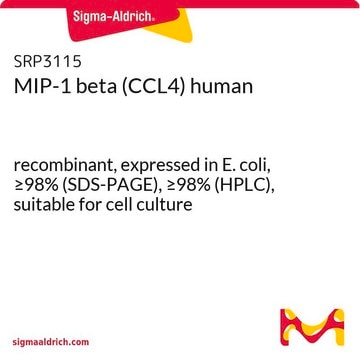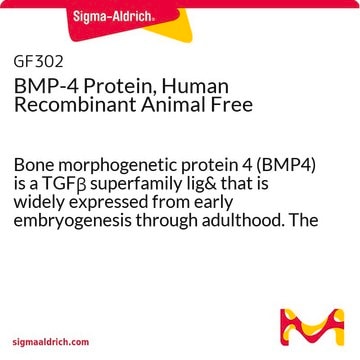SRP3249
MIP-1 beta from rat
recombinant, expressed in E. coli, ≥98% (SDS-PAGE), ≥98% (HPLC), suitable for cell culture
Synonym(s):
ACT-2, CCL4
Sign Into View Organizational & Contract Pricing
All Photos(1)
About This Item
UNSPSC Code:
12352202
NACRES:
NA.32
Recommended Products
biological source
rat
recombinant
expressed in E. coli
Assay
≥98% (HPLC)
≥98% (SDS-PAGE)
form
lyophilized
mol wt
7.8 kDa
packaging
pkg of 20 μg
technique(s)
cell culture | mammalian: suitable
impurities
<0.1 EU/μg endotoxin, tested
color
white to off-white
UniProt accession no.
shipped in
wet ice
storage temp.
−20°C
Gene Information
rat ... CCL4(116637)
General description
Both MIP-1α and MIP-1β are structurally and functionally related CC chemokines. They participate in the host response to invading bacterial, viral, parasite and fungal pathogens by regulating the trafficking and activation state of selected subgroups of inflammatory cells e.g. macrophages, lymphocytes and NK cells. While both MIP-1α and MIP-1β exert similar effects on monocytes their effect on lymphocytes differ; with MIP-1α selectively attracting CD8+ lymphocytes and MIP-1β selectively attracting CD4+ lymphocytes. Additionally, MIP-1α and MIP-1β have also been shown to be potent chemoattractants for B cells, eosinophils and dendritic cells. Both human and murine MIP-1α and MIP-1β are active on human and murine hematopoietic cells. Recombinant rat MIP-1a is a 7.8 kDa protein containing 69 amino acid residues, including the four highly conserved cysteine residues present in CC chemokines.
Biochem/physiol Actions
Both MIP-1a and MIP-1b are structurally and functionally related CC chemokines. Recombinant rat MIP-1b is a 7.8 kDa protein containing 69 amino acid residues, including the four highly conserved cysteine residues present in CC chemokines.
Sequence
APIGSDPPTS CCFSYTSRKI HRNFVMDYYE TSSLCSQPAV VFLTKKGRQI CADPSEPWVN EYVNDLELN
Physical form
Lyophilized with no additives.
Reconstitution
Centrifuge the vial prior to opening. Reconstitute in water to a concentration of 0.1-1.0 mg/ml. Do not vortex. This solution can be stored at 2-8°C for up to 1 week. For extended storage, it is recommended to further dilute in a buffer containing a carrier protein (example 0.1% BSA) and store in working aliquots at -20°C to -80°C.
Storage Class Code
11 - Combustible Solids
WGK
WGK 3
Flash Point(F)
Not applicable
Flash Point(C)
Not applicable
Certificates of Analysis (COA)
Search for Certificates of Analysis (COA) by entering the products Lot/Batch Number. Lot and Batch Numbers can be found on a product’s label following the words ‘Lot’ or ‘Batch’.
Already Own This Product?
Find documentation for the products that you have recently purchased in the Document Library.
Andrea Masotti et al.
BMC genomics, 16, 480-480 (2015-06-28)
MicroRNAs (miRs) are an abundant class of small non-coding RNAs (~22 nt) that reprogram gene expression by targeting mRNA degradation and translational disruption. An emerging concept implicates miR coupling with transcription factors in myeloid cell development and function, thus contributing to
S D Wolpe et al.
The Journal of experimental medicine, 167(2), 570-581 (1988-02-01)
We report the identification and purification of a new inflammatory monokine synthesized by the macrophage tumor cell line RAW 264.7 in response to endotoxin. This monokine, which we term "macrophage inflammatory protein" (MIP), is a doublet with an apparent molecular
Manuela Del Cornò et al.
Journal of virology, 88(19), 11045-11055 (2014-07-11)
Dendritic cells (DCs) are fundamental for the initiation of immune responses and are important players in AIDS immunopathogenesis. The modulation of DC functional activities represents a strategic mechanism for HIV-1 to evade immune surveillance. Impairment of DC function may result
Biology of the RANTES/SIS cytokine family.
T J Schall
Cytokine, 3(3), 165-183 (1991-05-01)
K Hieshima et al.
Journal of immunology (Baltimore, Md. : 1950), 159(3), 1140-1149 (1997-08-01)
By searching the expressed sequence tag (EST) database, we identified partial cDNA sequences encoding a polypeptide with significant sequence identity to the human CC chemokine macrophage-inflammatory protein-1 alpha (MIP-1 alpha)/LD78 alpha. We determined the complete cDNA sequence that contained a
Our team of scientists has experience in all areas of research including Life Science, Material Science, Chemical Synthesis, Chromatography, Analytical and many others.
Contact Technical Service







